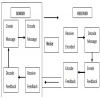Management Concepts & Organisational Behaviour - Group Dynamics
Types of Groups
Posted On :
The following types of groups coexist in every organization.
Types of
Groups
The following types of groups coexist in every organization.
i. Formal Groups: Formal Groups are a part of the organization structure. They are created deliberately by the management to perform the assigned duties. Work groups, committees and quality circles fall in this category. These groups are characterized by clear-cut authority-responsibility relationships. The pattern of communication is also well defined. Rules are laid down to regulate the behavior of group members.
The following types of groups coexist in every organization.
i. Formal Groups: Formal Groups are a part of the organization structure. They are created deliberately by the management to perform the assigned duties. Work groups, committees and quality circles fall in this category. These groups are characterized by clear-cut authority-responsibility relationships. The pattern of communication is also well defined. Rules are laid down to regulate the behavior of group members.
ii. Informal Groups: Informal groups arise
spontaneously at the work place
because of social interaction between the people. They are created by
individuals rather than by management. They are based on common interest,
language, taste, religion, background, etc. Thus, informal groups are alliances
that are not officially planned. These groups are natural entities in the work
environment. Informal groups are more flexible than the formal groups. Since
they concentrate on personal contacts between the members, they represent the
human side of enterprise as compared to technical side represented by the
formal groups.
iii. Command and Task Groups: Formal groups may be sub-classified into command and task groups. The command group is composed of subordinates who report directly to a common boss. Thus, a supervisor and the operative employees reporting to him form a command group. The task group, on the other hand, represents those working together to complete a given task. A task group or teams, say for the introduction of a new product or service, is usually formed to complete an assignment that involves a number of departments. Further, a command group is more permanent than a task group in the organization.
iii. Command and Task Groups: Formal groups may be sub-classified into command and task groups. The command group is composed of subordinates who report directly to a common boss. Thus, a supervisor and the operative employees reporting to him form a command group. The task group, on the other hand, represents those working together to complete a given task. A task group or teams, say for the introduction of a new product or service, is usually formed to complete an assignment that involves a number of departments. Further, a command group is more permanent than a task group in the organization.
iv. Interest and Friendship Groups: Informal alliances may take the shape of interest and friendship groups. An interest group consists of people having a specific objective and not aligned to common command or task groups. For instance, employees who group together to pressurize the management for free transport and other benefits constitute an interest group. But a friendship group includes close friends or relatives. These relations even extend outside the organization. The group members know each other very well and have good relations.
Tags : Management Concepts & Organisational Behaviour - Group Dynamics
Last 30 days 360 views













